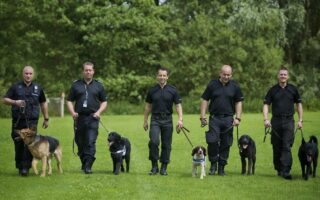In a world where wagging tails meet bustling streets and playful barks echo through backyards, the bond between humans and dogs is both profound and delightful. However, amidst the joy of companionship lies a crucial element often overlooked: obedience training. Picture a harmonious scene where pets and their owners navigate park pathways side by side, communicating seamlessly without the need for a single spoken word. Dog obedience training is not merely a tool for instilling discipline; it is a journey toward understanding, respect, and shared experiences. This article explores the fundamentals of dog obedience training—not just its techniques and methodologies, but its transformative potential to strengthen the bond between you and your furry friend, paving the way for a life filled with mutual respect and joy. Whether you’re a first-time dog owner or a seasoned handler, the insights shared here will guide you in nurturing a well-behaved companion and a more fulfilling relationship. Join us as we delve into the principles of effective training, the pitfalls to avoid, and the rewards that await those willing to invest in the art of obedience.
Table of Contents
- The Foundations of Canine Communication
- Positive Reinforcement Techniques for Lasting Results
- Common Challenges in Obedience Training and How to Overcome Them
- Building a Bond: The Role of Consistency in Training Success
- Q&A
- The Conclusion
The Foundations of Canine Communication
Understanding how dogs communicate is essential for effective obedience training. Dogs utilize a variety of signals that encompass both verbal and non-verbal forms of communication. These include body language, vocalizations, and even facial expressions, each contributing to their overall demeanor and intentions. Some key aspects to observe are:
- Posture: A dog’s stance can convey confidence, submission, or aggression.
- Tails: The position and movement of a dog’s tail often indicate their emotional state.
- Eyes: Direct eye contact can be a sign of dominance, while avoiding eyes may signify submissiveness.
- Ears: The position of a dog’s ears can reflect their mood—perked ears show interest, while flattened ears often indicate fear or anxiety.
Building a strong foundation in canine communication allows trainers to tailor their methods effectively. For instance, recognizing when a dog is overstimulated or stressed can prevent negative outcomes during training sessions. Additionally, creating an environment where a dog feels safe and understood fosters a deeper bond. Consider these important interactions:
| Dog Behavior | Trainer Response |
|---|---|
| Tail wagging enthusiastically | Reward with praise or treats |
| Backing away or hiding | Provide space and reassurance |
| Barking loudly | Assess situation, redirect focus |
Positive Reinforcement Techniques for Lasting Results
Incorporating positive reinforcement techniques can significantly enhance your dog obedience training experience. This approach encourages your dog to repeat desired behaviors by rewarding them with treats, praise, or playtime. Effective rewards create a positive association with obedience, making your dog more eager to learn. Here are some powerful strategies to implement:
- Immediate Rewards: Always reward your dog immediately after they perform the desired action to reinforce the connection.
- Variety of Treats: Use a variety of treats to keep your dog engaged and motivated; this can include small pieces of their favorite snacks or toys.
- Consistency is Key: Maintain consistent cues and commands to help your dog understand what’s expected.
- Short Sessions: Keep training sessions short but frequent to maintain your dog’s attention while making the learning process enjoyable.
Tracking your dog’s progress can also provide insights into their learning journey. Consider maintaining a simple chart to monitor their accomplishments and the behaviors you’re focusing on. The table below illustrates a straightforward way to track this:
| Skill/Command | Progress (1-5) | Notes |
|---|---|---|
| Sit | 4 | Responds well, need to improve duration. |
| Stay | 3 | Struggles with distractions. |
| Come | 5 | Perfect recall in familiar environments. |
Common Challenges in Obedience Training and How to Overcome Them
Obedience training can be a fulfilling experience, but it’s not without its hurdles. Many dog owners find that their furry companions exhibit behaviors that disrupt the training process. Some common issues include distractions, lack of motivation, and inconsistent commands. For instance, a dog might be easily distracted by noises or sights, causing interruptions during training sessions. To combat this, it’s crucial to create a controlled training environment free from distractions. Using high-value treats can also help improve focus, making your dog more willing to follow commands.
In addition to distractions, frustration stemming from insufficient progress can deter trainers. It’s essential to remember that each dog learns at its own pace. To tackle this challenge, implementing positive reinforcement and breaking down commands into smaller, manageable steps can yield better results. Consider using a training schedule to maintain consistency. Below is a simple table to illustrate effective strategies for common obedience challenges:
| Challenge | Solution |
|---|---|
| Distractions | Train in a quiet space with minimal interruptions. |
| Lack of motivation | Use high-value treats or favorite toys. |
| Inconsistent commands | Establish a clear set of commands and stick to them. |
Building a Bond: The Role of Consistency in Training Success
In the world of dog obedience training, the foundation for success lies in the consistency of interactions between trainer and dog. By establishing clear expectations through repetitive commands and routines, dogs learn to understand their training as a language of reassurance. Positive reinforcement should be consistently applied so that dogs can clearly associate desired behaviors with rewards. This method not only fosters trust but also builds a lasting bond that enhances the overall training experience. Regular practice sessions, sprinkled throughout the week, encourage dogs to absorb new skills without feeling overwhelmed, paving the way for effective learning.
Moreover, consistent training schedules can greatly impact a dog’s progress. Dogs thrive on routine, making it essential to set aside specific times for training. This structure provides them with a sense of security and predictability. Here are some fundamental aspects of consistency in training:
- Timing: Reinforce commands immediately to create strong associations.
- Environment: Train in various locations to generalize obedience.
- Command Structure: Use the same language and phrases each time.
Incorporating these elements seamlessly integrates learning into a dog’s daily life, making them more receptive to commands. A little planning and dedication go a long way in ensuring that training remains an engaging and fruitful experience for both the dog and the owner.
Q&A
Q&A: Dog Obedience Training Unleashed
Q1: Why is obedience training important for dogs?
A1: Obedience training is crucial because it establishes a solid foundation for a dog’s behavior. It enhances communication between the pet and owner, ensuring that commands are understood and followed. This training fosters a respectful relationship and promotes safety, allowing owners to take their dogs into various environments with confidence.
Q2: What age is best to start training a dog?
A2: The earlier, the better! Puppies can begin basic obedience training as early as 7-8 weeks old, when they’re most receptive to learning. Early socialization and exposure are vital for developing a well-rounded adult dog. However, older dogs can learn too, as they are always capable of behavioral change and improvement.
Q3: What commands should I teach my dog first?
A3: Start with fundamental commands: “Sit,” “Stay,” “Come,” “Down,” and ”Heel.” These commands are the building blocks of dog obedience. They help manage your dog’s behavior and can be the key to a safe and enjoyable walking experience. Plus, they’re great conversation starters at the dog park!
Q4: What techniques are best for training a dog?
A4: Positive reinforcement is a highly effective technique. This involves rewarding your dog with treats, praise, or playtime for good behavior. Consistency and patience are vital—always use the same command for each behavior and remain calm. Avoid punishment, as it can create fear rather than learning.
Q5: How long should training sessions be for my dog?
A5: Keep training sessions brief and engaging—around 5 to 15 minutes works best, depending on the dog’s age and attention span. Young puppies may focus for only a few minutes, while adult dogs can handle longer sessions. Always end on a positive note to maintain enthusiasm for future training!
Q6: How can I correct unwanted behaviors in my dog?
A6: Instead of focusing solely on correction, redirect your dog’s energy. For example, if your dog jumps on guests, employ commands like “Sit” or “Place” as alternatives. If your pet engages in excessive barking or digging, ensure they’re getting enough exercise and mental stimulation. Often, unwanted behaviors stem from boredom or excess energy.
Q7: How can I keep training fun for my dog?
A7: Variety is the spice of life! Incorporate games, new tricks, and hidden treats to keep things interesting. Change the environment occasionally—training at the park can help your dog adapt to distractions while still maintaining focus. Remember, a happy dog is a learning dog!
Q8: What resources can I use to improve my dog training skills?
A8: There’s a wealth of resources available! Books on canine behavior, online courses, and local obedience classes can offer valuable insights. Joining a dog training group or community can provide support and foster socialization for both you and your pup. Remember, even trainers need to keep learning!
Q9: How can I measure my dog’s progress in training?
A9: Progress may not always be linear, but you can track improvements by noting how reliably your dog obeys commands in different environments. Increasing the difficulty of commands or reducing rewards can also indicate growth. Celebrate small victories, and be patient—every dog learns at their own pace!
Q10: What if my dog doesn’t respond to training?
A10: Sometimes, dogs may need more time or a different approach. Assess the training method you’re using—what works for one dog may not work for another. If you find that you’re struggling, consider consulting a professional trainer or behaviorist who can provide personalized guidance. Remember, persistence and love will yield results!
dog obedience training is a journey filled with learning, patience, and plenty of tail-wagging moments. With the right techniques and a positive attitude, you and your dog can build a bond that goes beyond commands, creating a lifelong partnership based on trust and mutual respect.
The Conclusion
embarking on the journey of dog obedience training opens up a world of opportunities for both you and your four-legged companion. It cements a bond built on trust, understanding, and mutual respect while fostering a harmonious living environment. Remember, patience and consistency are your greatest allies; every small victory leads to the larger goal of a well-behaved dog. Whether you choose professional training or prefer to explore the myriad of resources available, what matters most is the commitment to improve communication with your furry friend. So gather those treats, don your training cap, and prepare for an adventure that strengthens your relationship, one command at a time. With every sit, stay, and come, you’re not just teaching your dog obedience—you’re nurturing a lifelong partnership filled with love and joy. Happy training!



